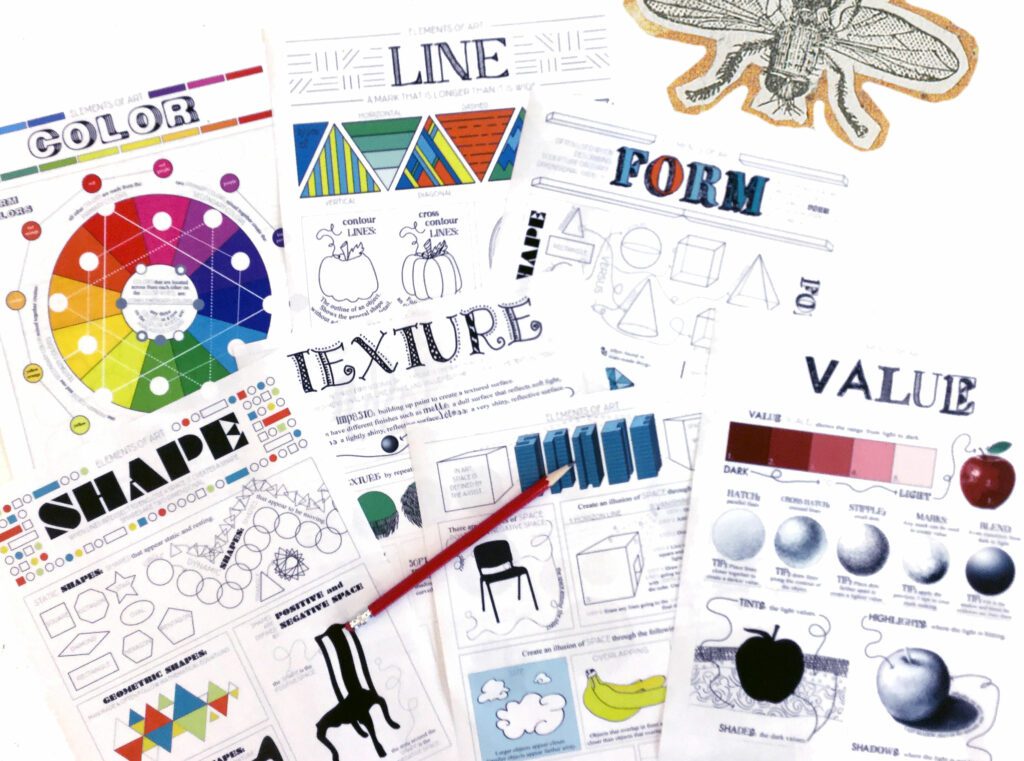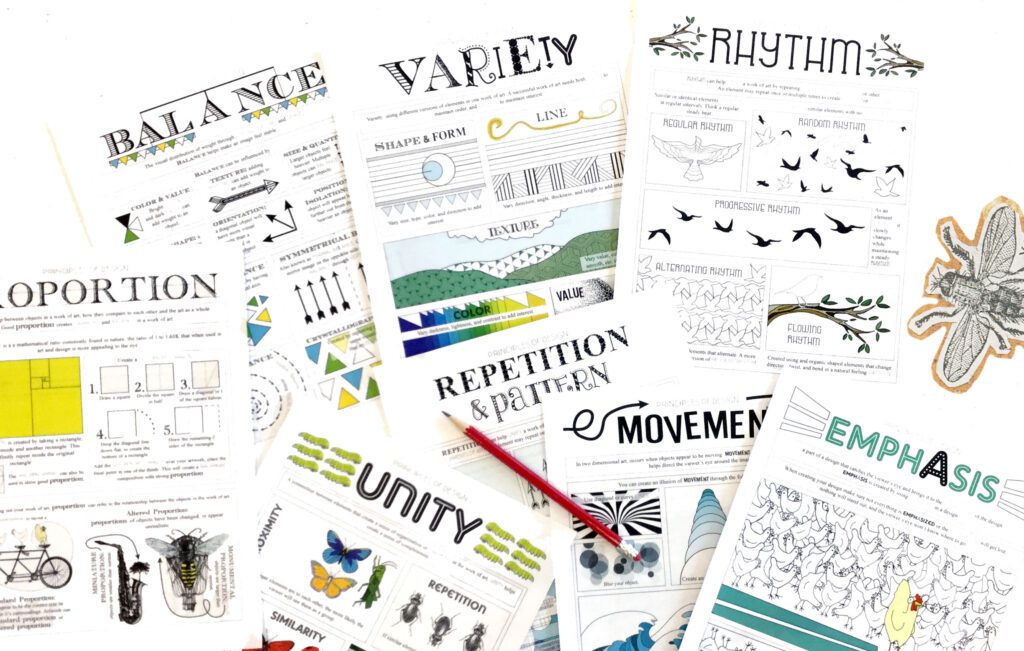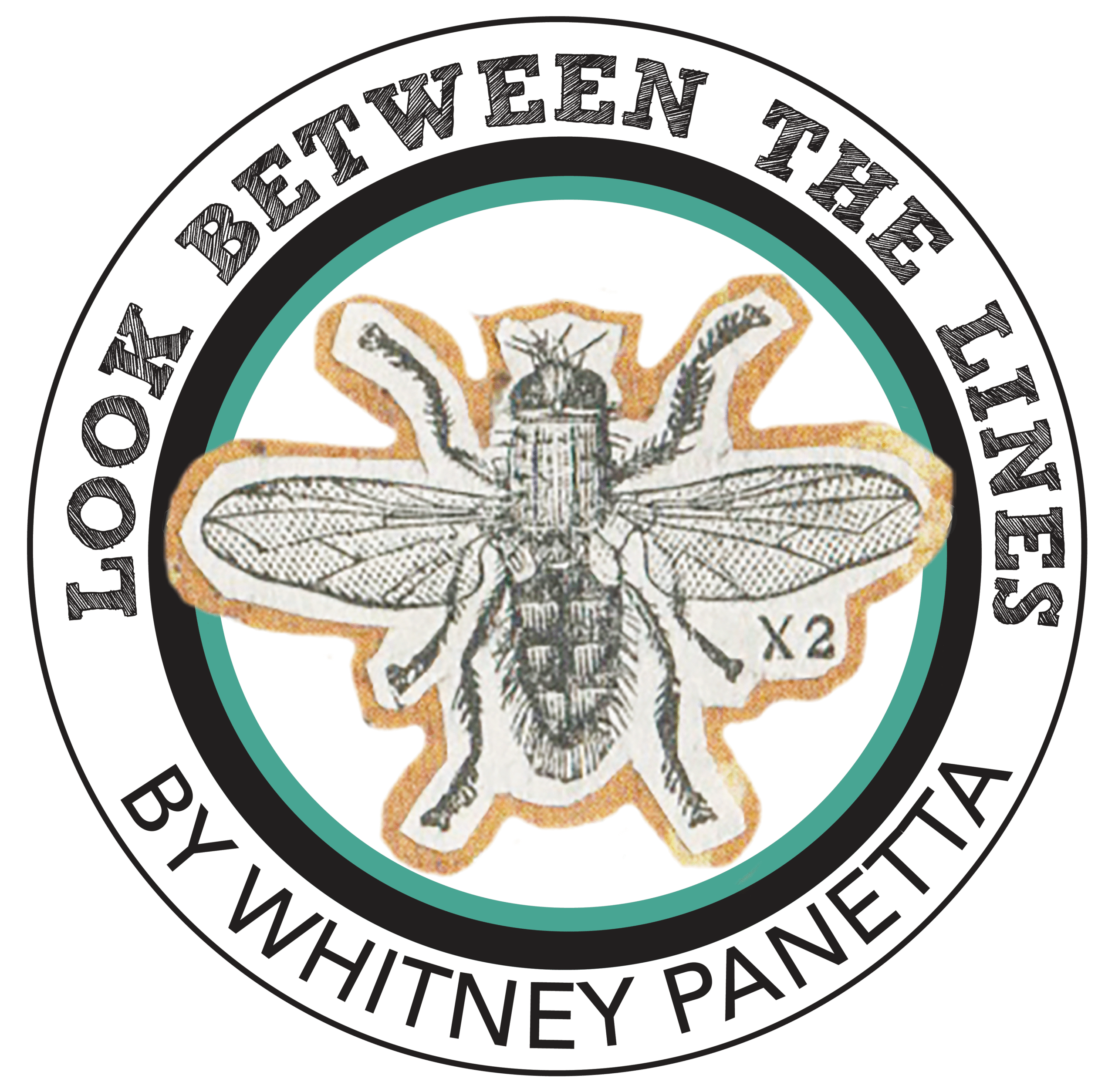
The elements of art and principles of design are important building blocks to helping art students understand how to create a successful work of art. Although creativity and effort always carry more weight when I grade student art, it is important to teach them concrete art concepts. I prefer to introduce the elements of art and principles of design alongside bigger activities and projects throughout the course rather than introducing them all at once. Check out how I use them in my art classes.
ELEMENTS OF ART
It’s wild to me how much the list of elements of art and principles of design can vary. This is the list of terms and definitions I have always used to guide my elements of art. Because these are the very basic building blocks of any work of art I introduce these first in my intro to art or art I classes. In upper-level art classes we review them regularly. Because they already have the base knowledge we don’t spend too much time learning about them, they are more entwined in our daily vocabulary and art discussions.
- Color: created when light reflects off of an object. In art, basic colors include primary colors, red, yellow, blue, and secondary colors, orange, green, and purple.
- Line: a mark that is longer than it is wide. Line can be used to create shapes and value.
- Shape: when lines intersect to enclose a space they create a shape. Shapes are two-dimensional.
- Form: often used when describing sculpture or three-dimensional objects. Two-dimensional art can create the illusion of form through perspective and shading.
- Texture: In three-dimensional art, texture refers to the way something feels when touched. In two-dimensional art lines, shapes, and value help imply the way an object feels.
- Space: Includes the area within and around an object. In art, space is defined by the artist.
- Value: The lightness or darkness of a color.
INTRODUCING THE ART CONCEPTS
In my intro to art classes I have a set of elements of art worksheets (check them out on my website here and on my TPT here) I use to introduce the concept. I pass out one worksheet every Monday and ask that it be completed by Friday. Because I dislike grading, rather than collecting and checking them every week, I have students add them to their art notebooks. I check their notebooks for completed activities halfway through the semester and at the end of the semester.
This method works for me because it provides an activity for students to work on in downtime or if they need a break from their project. The activity they are working on to fill time includes important information for the class. I reinforce what they learn working individually by highlighting one or two elements of art in projects. When I introduce the project we discuss the elements more in-depth and then see them come to life as they create their project.
The elements of art handouts can also be used as early finishers or fast finishers, emergency sub plans, or alongside projects to reinforce the element of art they are learning in the project.

PRINCIPLES OF DESIGN
The variations of principles of design lists have amazed me over the years. How this isn’t a standardized list yet is crazy! I am constantly evaluating my list to see if there are any too repetitive or something lacking. I recently had a request to add harmony, I can’t decide if it is too similar to unity. It may be added eventually! This is the list I typically stick to when teaching the principles of design.
- Balance: The visual distribution of weight through color, texture, and space. Balance helps make an image feel stable.
- Contrast: can help create a focal point in a work of art by placing contrasting elements next to each other. When placed next to each other, contrasting elements will grab your attention.
- Emphasis: a part of a design that catches the viewer’s eye and brings it to the focal point of the design. Emphasis is created by using contrast in a design.
- Movement: In two-dimensional art, movement occurs when objects appear to be moving. Movement creates a sense of excitement and helps direct the viewer’s eye around the image.
- Proportion: The relationship between objects in a work of art, how they compare to each other, and the art as a whole. Good proportion creates harmony and balance in a work of art.
- Repetition: when an element is used multiple times in a work of art. Repetition can help unify a work of art by repeating lines, shapes, colors, or other elements of art.
- Pattern: an element that repeats multiple times to create a design.
- Rhythm: created when elements are repeated at regular intervals to create a sense of movement and unity in a work of art. Rhythm can help unify a work of art by repeating lines, shapes, colors, or other elements of art.
- Unity: a connection between elements that create a sense of organization or harmony in a work of art. Unity helps create a sense of completeness.
- Variety: using different versions of elements in one work of art. A successful work of art needs both unity, to maintain order, and variety, to maintain interest.
Similar to how I introduce the elements of art I use handouts to initially introduce the principles of design. Because the principles of design use the elements of art as a base, I introduce these after students have an understanding of the elements. Check out my principles of design worksheets on my website here or my TPT shop here.
I recently bundled these two worksheet packs into one big bundle for a discount. You can snag it on my website here or my TPT shop here. In addition to these elements of art and principles of design worksheets, I also have another set I use to reinforce concepts in other art classes. Check them out on my website here or TPT here.
Stay tuned for an elements of art and principles of design presentation if you want to cover them all at once. Get updated on new products by following my TPT shop or getting on my email list. Don’t forget to follow me on Instagram and TikTok for weekly visual journal demos and other project ideas. Until next time!

0 Comments